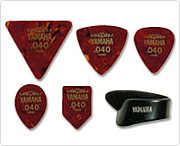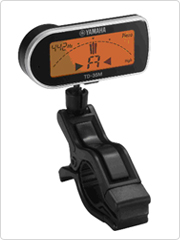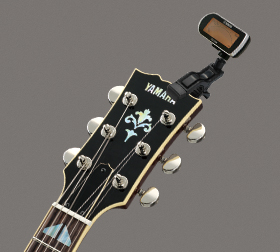Choosing an Electric Guitar
Must-have accessories
Picks
Picks are made from a wide variety of materials, including celluloid, nylon, tortoiseshell, and metal. From flat picks with triangular or raindrop shapes, to thumb picks you wear on your thumb and steel picks worn on the fingers, picks also come in many shapes.
Celluloid picks are the standard choice for many guitarists. These picks come in three varieties: heavy and hard (H), thin and soft, and those that are somewhere between these two extremes (M). Although it certainly depends on the song, many guitarists choose to use celluloid hard picks or tortoiseshell picks when playing lead guitar, and soft picks when playing rhythm guitar.

Various picks
Spotlight on clip-on tuners

A clip-on tuner
When a guitarist picks up a guitar, the first thing he or she must do is tune it. Guitars used to be tuned with tuning forks or pitch pipes. Guitarists would strike the tuning fork and then adjust their instruments with the fork in their mouths. There was definitely something cool about that! Of course, tuning by ear is still the standard. While being able to do this is important, a guitarist does not always have the time or luxury of sitting down and taking the time to tune his or her instrument by ear. For example, you would not want to turn a guitar by ear in a very noisy environment, such as during a live event, backstage, or on the stage. A tuner comes in very handy in these cases.
Most electric guitar tuners are connected to the guitar by a cable through which they pick up sound. The guitarist then tunes his or her instrument with the help of a meter on the tuner. However, in this section we would like to mention clip-on tuners which are clipped to instrument.
These tuners are clipped to some part of the instrument, allowing the player to tune his or her instrument-whether an acoustic guitar, electric guitar, violin, or even wind instrument. In addition to being easy to install, they are capable of detecting pitch from the vibration of the body and are resistant against noise. Finally, they can be left on the instrument even when playing, since they are small and light. This keeps the meter in sight at all times, allowing the player to tune his or her instrument quickly-even in between songs.
Clip-on tuners are even more beneficial for players of electric guitars, as the devices allow for tuning even when the guitar's volume is turned down (i.e. no output is required). There is no need to wedge the tuner between the guitar and amplifier, which is also good for the sound quality.

Simply clip it to your instrument and start tuning
Do I need an effector too?
Electric guitars were originally played connected directly to amplifiers, so they can of course be played without an effector.
Effectors are used to add effects to the timbre of sound created by an electric guitar not possible with an amplifier alone. Although there are many kinds of effectors, the main types are summarized below:
Effectors that distort sound: Distortion, fuzz, overdrive
These effectors are used to produce a strongly distorted sound that an amplifier alone could not generate, or in cases where the sound from the amplifier should be left distortion-free and then distorted when needed. Distortion and fuzz effectors produce even more distortion than overdrive effectors.
Effectors that add reverberation: Delay, reverb
Delay effectors add an echo effect to sound, while reverb effectors add a reverberation effect. Reverb effects are often built-in to guitar amplifiers.
Effectors that expand sound: Chorus
When applied to clean and undistorted sound, these effectors produce an expansive and beautiful sound.
Effectors that cause sound to waver: Phase shifter (phaser), flanger, vibrato, etc.
Phase shifter effectors produce a sound resembling that of a rotary speaker. Flanger effectors can generate a jet sound effect. Vibrato effectors cause the pitch to waver.
Effectors with other special effects: Wah-wah, octaver, etc.
Wah-wah effectors are structured like pedals and when stepped on give the guitar sound a "wah-wah" effect. Octaver effectors add a sound that is one octave lower. Some recent effectors even combine several of these functions.
This section covers only some of the effectors that are available. The most commonly used are the distortion, chorus, and delay effectors.
Musical Instrument Guide:Electric Guitar Contents
Structure
How to Play
How the Instrument is Made
Choosing an Instrument
Care and Maintenance
Trivia
- Slide guitar playing may have been invented in a bar
- Feedback:Great for guitar playing! Not so great for karaoke...
- What is the difference between an electric guitar and electric acoustic guitar?
- Is there a way to eliminate the noise heard when plugged into an amplifier?
- Whole note down tuning for deeper bass
